NASA facilities
There are NASA facilities across the United States and around the world. NASA Headquarters in Washington, DC provides overall guidance and political leadership to the agency.[1] There are 10 NASA field centers, which provide leadership for and execution of NASA's work. All other facilities fall under the leadership of at least one of these field centers.[2] Some facilities serve more than one application for historic or administrative reasons. NASA has used or supported various observatories and telescopes, and an example of this is the NASA Infrared Telescope Facility. In 2013 a NASA Office of the Inspector General's (OIG) Report recommended a Base Realignment and Closure Commission (BRAC) style organization to consolidate NASA's little used facilities.[3] The OIG determined at least 33 of NASA's 155 facilities were underutilized.
List of field centers
NASA has ten field centers.[4] Four of these were inherited from its predecessor, the National Advisory Committee for Aeronautics (NACA); two others were transferred to NASA from the United States Army; and NASA commissioned and built the other four itself shortly after its formation in 1958.
Inherited from NACA
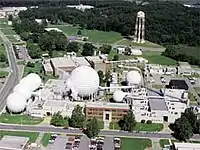
Langley Research Center (LaRC), founded in 1917, is the oldest of NASA's field centers, located in Hampton, Virginia. LaRC focuses primarily on aeronautical research, though the Apollo lunar lander was flight-tested at the facility and a number of high-profile space missions have been planned and designed on-site. Established in 1917 by the National Advisory Committee for Aeronautics, the Center currently devotes two-thirds of its programs to aeronautics, and the rest to space. LaRC researchers use more than 40 wind tunnels to study improved aircraft and spacecraft safety, performance, and efficiency. Starting in 1958, when NASA started Project Mercury, LaRC housed the Space Task Group, which was expanded into the Manned Spacecraft Center and moved to Houston in 1961–1962.[5] The selection of Houston as the location of the Manned Spacecraft Center resulted in some controversy at NASA Langley and in the surrounding area at the time, given they had previously expected either for Langley to be expanded or for a nearby location in the Hampton Roads region to be selected for the center.[6]
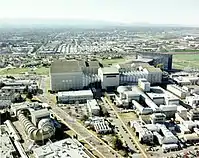
Ames Research Center (ARC) at Moffett Field was founded on December 20, 1939. The center was named after Joseph Sweetman Ames, a founding member of the NACA. ARC is one of NASA's 10 major field centers and is located in California's Silicon Valley. Historically, Ames was founded to do wind-tunnel research on the aerodynamics of propeller-driven aircraft; however, it has expanded its role to doing research and technology in aeronautics, spaceflight, and information technology. It provides leadership in astrobiology, small satellites, robotic lunar exploration, intelligent/adaptive systems and thermal protection.
John H. Glenn Research Center (GRC), formerly the Lewis Flight Propulsion Laboratory, located in Brook Park, Ohio, was established in 1942 as a laboratory for aircraft engine research. In 1999, the center was officially renamed the NASA John H. Glenn Research Center at Lewis Field after John Glenn, an American fighter pilot, astronaut and politician. Glenn supports all of the agency's missions and major programs. Glenn excels in researching and developing innovative technologies for both aeronautics and space flight. A multitude of NASA missions have included elements from Glenn, from the Mercury and Gemini projects to the Space Shuttle Program and the International Space Station. The center's core competencies include air-breathing and in-space propulsion and cryogenics, communications, power energy storage and conversion, microgravity sciences, and advanced materials.
Armstrong Flight Research Center (AFRC), established by NACA before 1946 and located inside Edwards Air Force Base, is NASA's premier site for aeronautical research and operates some of the most advanced aircraft in the world. It is also the home of the Shuttle Carrier Aircraft (SCA), a modified Boeing 747 designed to carry a Space Shuttle orbiter back to Kennedy Space Center if one lands at Edwards. On January 16, 2014, the center previously known as Dryden was renamed in honor of Neil Armstrong, the first astronaut to walk on the Moon.[7][8]
Transferred from the Army
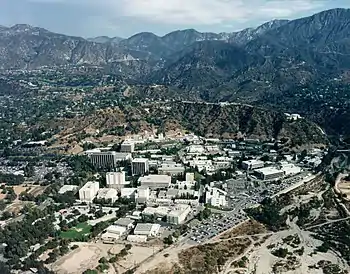
The Jet Propulsion Laboratory (JPL), located in the San Gabriel Valley area of Los Angeles County, CA, was, together with ABMA, one of the agencies behind Explorer 1, America's first robotic satellite, and also together with ABMA one of the first agencies to become a part of NASA. The facility is headquartered in the city of La Cañada Flintridge [9] [10] with a Pasadena mailing address . JPL is managed by the nearby California Institute of Technology (Caltech). The Laboratory's primary function is the construction and operation of robotic planetary spacecraft, though it also conducts Earth-orbit and astronomy missions. It is also responsible for operating NASA's Deep Space Network.
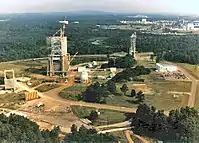
George C. Marshall Space Flight Center (MSFC), located on the Redstone Arsenal near Huntsville, Alabama, is one of NASA's largest centers. MSFC is where the Saturn V rocket and Spacelab were developed. Marshall is NASA's lead center for International Space Station (ISS) design and assembly; payloads and related crew training; and was the lead for Space Shuttle propulsion and its external tank. From December 1959, it contained the Launch Operations Directorate, which moved to Florida to become the Launch Operations Center on July 1, 1962.
Built by NASA
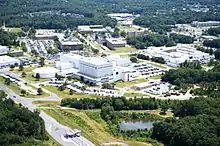
Goddard Space Flight Center (GSFC), located in Greenbelt, Maryland, was commissioned by NASA on March 1, 1959. It is the largest combined organization of scientists and engineers in the United States dedicated to increasing knowledge of the Earth, the Solar System, and the Universe via observations from space. GSFC is a major U.S. laboratory for developing and operating unmanned scientific spacecraft. GSFC conducts scientific investigation, development and operation of space systems, and development of related technologies. Goddard scientists can develop and support a mission, and Goddard engineers and technicians can design and build the spacecraft for that mission. Goddard scientist John C. Mather shared the 2006 Nobel Prize in Physics for his work on COBE. GSFC also operates two spaceflight tracking and data acquisition networks (the Space Network and the Near Earth Network), develops and maintains advanced space and Earth science data information systems, and develops satellite systems for the National Oceanic and Atmospheric Administration (NOAA).
John C. Stennis Space Center, originally the Mississippi Test Facility, is located in Hancock County, Mississippi, on the banks of the Pearl River at the Mississippi–Louisiana border. Commissioned on October 25, 1961, it was NASA's largest rocket engine test facility until the end of the Space Shuttle program. It is currently used for rocket testing by over 30 local, state, national, international, private, and public companies and agencies. It contains the NASA Shared Services Center.[11]

Lyndon B. Johnson Space Center (JSC) is the National Aeronautics and Space Administration's center for human spaceflight training, research and flight control. Created as the Manned Spacecraft Center on November 1, 1961, the facility consists of a complex of 100 buildings constructed in 1962–1963 on 1,620 acres (656 ha) of land donated by Rice University in Houston, Texas.[12] The center grew out of the Space Task Group formed soon after the creation of NASA to co-ordinate the US human spaceflight program. It is home to the United States Astronaut Corps and is responsible for training astronauts from the U.S. and its international partners, and includes the Christopher C. Kraft Jr. Mission Control Center.[12] The center was renamed in honor of the late U.S. president and Texas native Lyndon B. Johnson on February 19, 1973.[13][14]
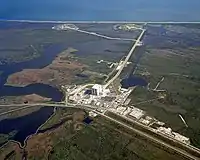
John F. Kennedy Space Center (KSC), located west of Cape Canaveral Space Force Station in Florida, is one of the best known NASA facilities. Named the Launch Operations Center at its creation on July 1, 1962, it was renamed in honor of the late U.S. president on November 29, 1963,[15][16] and has been the launch site for every United States human space flight since 1968. KSC continues to manage and operate unmanned rocket launch facilities for America's civilian space program from three pads at Cape Canaveral. Its Vehicle Assembly Building (VAB) is the fourth-largest structure in the world by volume[17] and was the largest when completed in 1965.[18] A total of 13,100 people worked at the center as of 2011. Approximately 2,100 are employees of the federal government; the rest are contractors.[19]
Other facilities
.jpg.webp)
Canberra Deep Space Communication Complex (CDSCC) is a ground station that is located in Australia at Tidbinbilla outside Canberra. The complex is part of the Deep Space Network run by JPL. It is commonly referred to as the Tidbinbilla Deep Space Tracking Station and was officially opened on 19 March 1965. The station is separated from Canberra by the Coolamon Ridge, Urambi Hills and Bullen Range that help shield the city's radio frequency (RF) noise from the dishes.
In addition to JPL (above), there are other Government-Owned / Contractor-Operated NASA facilities operated under grant provisions, such as the Space Telescope Science Institute at Johns Hopkins University which operates the Hubble Space Telescope.
Organization
NASA headquarters, Washington, D.C.
- Ames Research Center
- Armstrong Flight Research Center
- John H. Glenn Research Center at Lewis Field
- Goddard Space Flight Center
- Jet Propulsion Laboratory
- Lyndon B. Johnson Space Center
- John F. Kennedy Space Center
- Langley Research Center
- George C. Marshall Space Flight Center
- John C. Stennis Space Center
List of minor facilities
Communication and telescope facilities
|
Manufacturing, test and research facilities
|
See also
- Category:NASA facilities
- Category:NASA groups, organizations, and centers
- List of NASA Visitor Centers
- Columbia Scientific Balloon Facility
- Crawlerway
- Lunar Sample Laboratory Facility
- National Transonic Facility
- Shuttle Landing Facility
References
- Shouse, Mary (July 9, 2009). "Welcome to NASA Headquarters". Retrieved July 15, 2009.
- "NASA Center Assignments by State". NASA. 2012-09-10. Retrieved 2013-01-23.
- "Does NASA Need a Closure Commission To Shut Down Idle Facilities? - SpaceNews.com". 1 April 2013.
- "NASA Facilities and Centers" (PDF). NASA. Retrieved July 30, 2020.
- Swenson Jr., Lloyd S.; Grimwood, James M.; Alexander, Charles C. "Space Task Group Gets a New Home and Name". This New Ocean, SP-4201. NASA. Retrieved July 24, 2019.
- Korsgaard, Sean (20 July 2019). "Williamsburg recalls watching Apollo 11 and helping crew get there". Virginia Gazette, Daily Press. Tribune Media. Retrieved 24 July 2019.
- "House passes bill to rename NASA facility for Armstrong". Spaceflight Now. 2012-12-31. Retrieved 2013-01-01.
- "NASA Center Redesignated for Neil Armstrong; Test Range for Hugh Dryden".
- https://www.pasadenastarnews.com/science/20160713/why-does-everyone-say-nasas-jpl-is-in-pasadena-when-this-other-city-is-its-real-home
- https://www.jpl.nasa.gov/about/maps/
- Dubuisson, Rebecca (July 19, 2007). "NASA Shared Services Center Background". Archived from the original on July 16, 2009. Retrieved July 15, 2009.
- NASA. "Lyndon B. Johnson Space Center". Retrieved 2008-08-27.
- "Houston Space Center Is Named for Johnson". The New York Times. February 20, 1973. p. 19.
- Nixon, Richard M. (February 19, 1973). "50 - Statement About Signing a Bill Designating the Manned Spacecraft Center in Houston, Texas, as the Lyndon B. Johnson Space Center". Retrieved July 9, 2011.
- "The National Archives, Lyndon B. Johnson Executive Order 11129". Retrieved April 26, 2010.
- "Kennedy Space Center Story". NASA. 1991. Retrieved November 5, 2015.
- Beattie, Rich (20 December 2011). "World's Biggest Buildings". Retrieved 6 December 2015.
- "Senate". Congressional Record: 17598. September 8, 2004.
- Dean, James (17 March 2011). "NASA budget woes leads to layoffs". Federal Times. Retrieved 21 August 2011.
